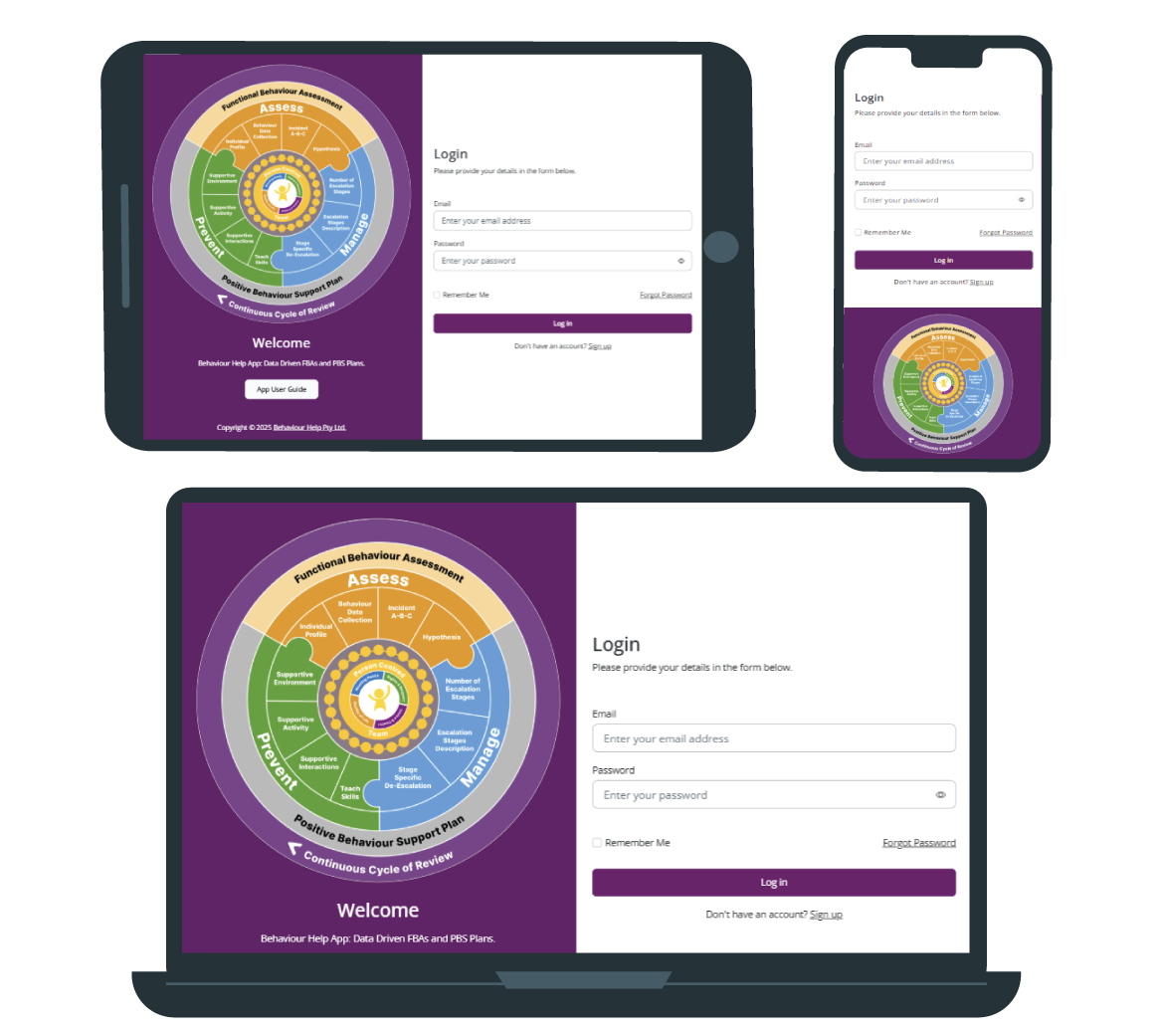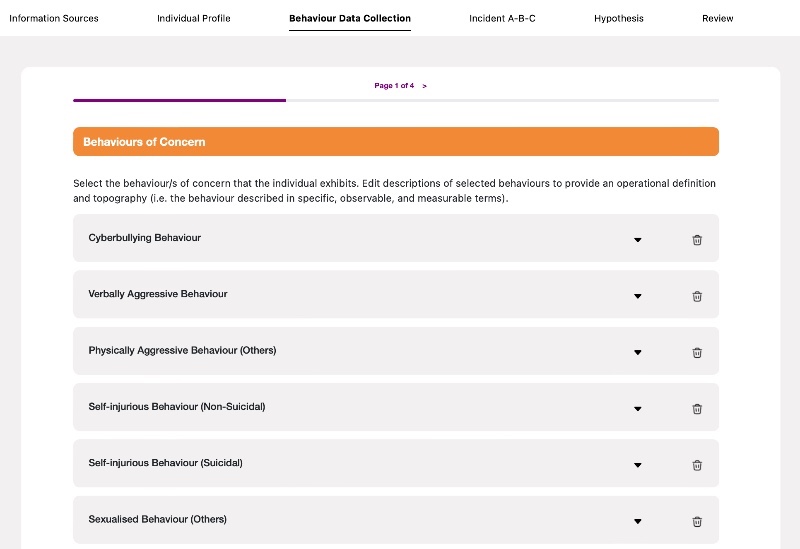At its core, behaviour tracking explores the ABCs of behaviour:
-
Antecedent – what happens immediately before the behaviour
-
Behaviour – what the student does
-
Consequence – what happens after the behaviour
Most behaviours of concern emerge because a need—sensory, social, emotional, or environmental—is not being met. The classroom might be too bright, the work too hard, the playground too noisy, or a routine may have unexpectedly changed. Any of these can tip a student from a regulated state into a dysregulated one.
By systematically recording what leads up to the behaviour and what follows it, we begin to identify patterns. Those patterns guide us toward practical, person‑centred strategies that reduce behaviours of concern and increase desired behaviours and skills.
This guide explains the basics of tracking behaviour and offers practical tips, templates, and digital tools—especially the Behaviour Help App—to make data collection seamless and analysis meaningful.
To learn more about behaviour of concern and what makes a behaviour concerning with a definition and a guide, read our article Behaviours of Concern and Positive Behaviour Support.

Introducting...The Behaviour Help App
Your All-in-One AI Tool for FBAs and PBS plans
You’re doing important work. That’s why we built the Behaviour Help App — to make it easier to track behaviour trends, identify patterns, and develop meaningful, person-centred strategies.
What is Behaviour Tracking?
Behaviour tracking is the deliberate, structured recording of specific behaviours of concern as they occur. Effective behaviour tracking doesn’t just describe what a student did—it quantifies how often, how long, and how intensely the behaviour occurred. These three dimensions—frequency, duration, and intensity—help transform qualitative observations into measurable, actionable data.
For more Frequently asked questions see the Behaviour Tracking FAQ.
Tracking Frequency, Duration, and Intensity: Making Behaviour Data Meaningful
Frequency refers to how often a behaviour occurs within a specific timeframe. This might be counted in incidents per hour, day, or session. Tracking frequency helps determine whether a behaviour is becoming more or less frequent over time and can highlight patterns linked to routines, environments, or emotional states.
Duration measures how long the behaviour lasts from start to finish. For example, a meltdown lasting 30 seconds may require different supports than one that continues for 20 minutes. Tracking duration is particularly helpful for behaviours such as withdrawal, screaming, or task refusal, where length of time reflects regulation difficulty.
Intensity captures the severity or impact of the behaviour. It can be rated on a consistent scale such as low, moderate, or high intensity, based on observable features (e.g., volume of yelling, force of physical aggression, or extent of property damage). Intensity ratings help teams identify which behaviours require immediate response and which can be supported through low-arousal techniques.
When using digital tools like the Behaviour Help App, frequency, duration, and intensity can be entered alongside the ABC data for each incident. This allows the app to generate automatic graphs and summaries—helping teams visualise trends across time, identify escalation cycles, and evaluate the impact of intervention strategies.
When you are tracking behaviour, parents, teachers, support staff, or allied health professionals usually note:
When the Behaviour happened
Record the exact date and time of each behaviour incident. This helps identify patterns linked to specific times of day, routines, or even physiological factors like fatigue or hunger.
Where it took place
Note the setting and activity during which the behaviour occurred. Was it in the classroom, playground, hallway, or at home? Context matters, and behaviours often surface in specific environments.
What preceded it
Identify the antecedents or triggers that happened immediately before the behaviour. This might include a change in routine, a specific instruction, peer interaction, or sensory input.
What the student did
Describe the behaviour in detail, including what was observed, how long it lasted, and its intensity. Aim for objective language—focus on actions, not interpretations or feelings.
How others responded and what followed
Record the consequence—what happened immediately after the behaviour. Did staff intervene? Did the student leave the area, receive attention, or gain access to something? This helps identify what may be reinforcing the behaviour.
Purpose of Behaviour Tracking
Behaviour tracking serves several crucial purposes in supportive environments.
First and foremost, it helps us see the invisible. Behaviour is a form of communication, and through consistent data collection we can begin to identify patterns and triggers that would otherwise remain hidden. This includes things like sensory overload, social skill challenges, anxiety responses, or undiagnosed learning difficulties.
Behaviour tracking also plays a vital role in developing Functional Behaviour Assessments (FBAs). The recorded data forms the backbone of an FBA, enabling the support team to form hypotheses about the function of a behaviour—whether it’s an attempt to escape a task, gain attention, seek sensory input, or access a tangible reward.
Equally important is the ability to evaluate the effectiveness of strategies over time. By comparing behaviour before, during, and after a targeted intervention, professionals can measure outcomes and make evidence-based decisions about what is working—and what needs to change.
Tracking promotes better collaboration and communication across multidisciplinary teams. Rather than relying on subjective opinions or anecdotal impressions, team members can refer to clear, shared data. This creates a unified understanding of the student’s behaviour and ensures that all parties are working from the same foundation.
Moreover, tracking provides transparency and accountability. In many settings, such as schools or NDIS-funded programs, having a reliable record of behaviour incidents is not just best practice—it’s a requirement. Documented evidence supports reviews, funding applications, and care planning.
Finally, and perhaps most powerfully, behaviour tracking can support the student’s voice. Patterns in the data may highlight when and where a student is most settled, engaged, or successful. This information is essential for building strengths-based plans and empowering the student to play a more active role in their own journey.
Agreeing on The Behaviour Of Concern
An essential component of tracking behaviour is to make sure everyone involved agrees on what the observed behaviour of concern is. Even if working alone, it's important to track specific behaviours else the data collected will become muddled and lead to challenges when we want to analyse data.
In a lot of cases, the individual you are supporting will likely exhibit one negative behaviour that you probably already observed is becoming a behaviour of concern regularly.
However, there may be situations where the individual has multiple negative behaviours. They may be triggered by different things and have different effects on themselves and those around them.
You can definitely track multiple student behaviours at a time just so long as you can identify which behaviour you are recording data for when it occurs and anyone else working alongside you also undertakes data collection with the same understanding.
Tools and Resources For Behaviour Data Collection
In years gone by, teachers and support staff would rely solely on paper-based systems to record track student behaviour. These often included printed ABC forms, tick-box tally sheets, and handwritten notes.
While simple and accessible, paper forms present challenges when it comes to storing, sharing, and analysing data—especially if you want to track frequency over time or compare positive and negative behaviours across multiple settings.
Behaviour Help App
Today, there are far more efficient and flexible tools available. Digital solutions, such as the Behaviour Help App, have revolutionised behaviour data tracking. Designed specifically for educators and support teams, the app enables users to record data quickly and consistently, ensuring no key information is missed. Behaviour records are stored securely and can be instantly visualised using built-in graphs that show the frequency of both positive and negative behaviours.
Read 'Successful Behaviour tracking with the Behaviour help App' for more information on how behaviour tracking works in a digital setting.
One major advantage of using an app is the ability to ensure that data is collected in real time. Teachers no longer have to rely on memory or end-of-day notes. Instead, behaviours can be logged as they occur—leading to a far more accurate record. The app also allows for custom prompts and reminders, helping to ensure consistent tracking even during busy school days.
Paper-based methods can still have their place, especially in early-stage tracking or in environments with limited digital access. Printable ABC sheets or simple tally templates can be effective for short-term observation.
One major advantage of using a digital behaviour data collection solution is that when multiple people collect data, it is collected in a consistent way. App's can guide users through the data collection process leaving less room for error and interpretation.
Ultimately, a consistent approach to data collection leads to simpler and more effective analysis with less effort on the teacher or parent's part. This helps build a positive relationship with the process of tracking behaviour which can feel laborious if done on paper.
Whether you’re using traditional forms or a digital app, the goal remains the same: to collect consistent, high-quality behaviour data that supports effective intervention and meaningful outcomes. But for those looking for the most streamlined, collaborative, and insightful approach, the Behaviour Help App remains the simplest and most powerful tool available today.
Behaviour Data Collection Forms
The Behaviour Help App also supports structured, collaborative data collection through customisable behaviour data collection (BDC) forms. Learn more about data collection in the Behaviour Help App user guide.
Users can start by selecting the specific behaviours of concern that the individual exhibits. Then, by clicking ‘Create New Form +’, they can personalise the BDC form to match the individual’s support needs and behavioural profile.

To support collaborative tracking across multiple environments (e.g. school, home, therapy sessions), the app enables users to send a web link or QR code to team members, allowing multiple data collectors to contribute. These forms support both daily logs and detailed ABC (Antecedent–Behaviour–Consequence) incident reporting, which promotes consistent and comprehensive tracking across all settings.
Once the forms are completed, the app collates the metric data—such as frequency, duration, and intensity—and automatically generates visual graphs. These can be viewed by entering a custom date range, making it easy to analyse behaviour patterns over days, weeks, or months.
The final step involves analysing these visual representations to identify trends, escalation patterns, or changes in response to intervention. The app also allows users to export data for sharing with multidisciplinary teams or incorporating into formal assessments like Functional Behaviour Assessments (FBAs) or Behaviour Support Plans (BSPs).
By combining flexible data entry with automated analysis, the Behaviour Help App transforms behaviour tracking from a time-consuming task into a streamlined, collaborative, and insightful process.
Example Behaviour Data
To bring this theory to life, here’s a fictional example of ABC behaviour tracking for a student named Milo, a 9-year-old who often refuses to transition between classroom activities. This refusal has become a behaviour of concern because it disrupts learning, causes distress and is making classroom management increasingly challenging.
|
Date/Time |
Antecedent (What happened before) |
Behaviour (What the student did) |
Consequence (What happened after) |
Duration |
Intensity |
Setting/Activity |
|---|---|---|---|---|---|---|
|
18/06/2025 9:05am |
Teacher gave a 2-minute warning before transitioning from art to maths. |
Milo hid under the table and refused to move. |
Teacher asked teaching assistant to coax him out. Maths started without him. |
12 minutes |
Moderate |
Classroom – transition time |
|
19/06/2025 9:07am |
Class was finishing silent reading and moving to group discussion. |
Milo shouted “I’m not doing it!” and tore his worksheet. |
He was removed to the calm space and missed the first 10 minutes of the group activity. |
6 minutes |
High |
Classroom – transition time |
|
20/06/2025 9:03am |
Visual schedule updated with transition warning. Milo had input in choosing next task. |
Hesitated, then joined the group reluctantly. |
Praised for participating, sat with peer of choice. |
2 minutes |
Low |
Classroom – transition time |
|
21/06/2025 9:00am |
No transition warning, straight instruction to switch activities. |
Put his head down and didn’t respond. |
After a few minutes, teacher reminded him of the next task. Milo joined late but without protest. |
4 minutes |
Low/Moderate |
Classroom – transition time |
How Long Should Behaviour Tracking Take Place Before Making an Intervention?
One of the most common questions teachers and support staff ask is: how long do I need to track behaviour data before I can do something about it? The answer depends on the behaviour of concern, the school setting, and how quickly patterns emerge.
In general, behaviour tracking should continue long enough to identify patterns with confidence. This typically means collecting data consistently over a minimum of one to two weeks, but sometimes longer—especially if the behaviour doesn’t occur daily or if the triggers and consequences vary depending on the environment, activity, or people present.
Allow Enough Time For The Student to Run Through Routines a Few Times
In a school setting, it’s common to track across different times of day, activities, and locations—such as lessons, break times, transitions, and group work. This helps to determine whether the behaviour is isolated to a particular context or more generalised. For example, a student might only display a behaviour of concern during maths class, or only during lunch in the playground. The goal of behaviour tracking is to gather enough data to accurately determine what precedes and follows the behaviour in a variety of situations.
If you’re using tools like the Behaviour Help App, patterns may become visible more quickly because the data is graphed and compared automatically. You may start to see trends in frequency, intensity, or triggers after just a few entries. But even in digital systems, best practice is to track for at least five to ten incidents of the target behaviour before drawing strong conclusions or initiating a formal intervention.
Immediate Term Interventions Don't Have to Wait
However, intervention doesn’t always mean waiting weeks to act. If the behaviour is high risk or significantly disruptive, short-term supports—like offering sensory breaks or adjusting seating—can be put in place immediately, even while full data collection continues. These initial strategies can be reviewed and refined as more behaviour data is gathered.
The key is not to rush to conclusions based on one or two incidents. Behaviour is complex and context-dependent. By committing to a structured time period of observation, teams are better equipped to make decisions based on evidence—not guesswork.
Once enough consistent behaviour data is collected and patterns are clear, the next step is to match those patterns to strategies that are person-centred, proactive, and positive. In this way, behaviour tracking becomes the foundation for truly effective intervention.
When Behaviour Tracking Becomes a Lifelong Support Mechanism
In some situations, especially where a student or individual has a disability, neurological difference, or complex trauma history, it may not be possible to fully eliminate a behaviour of concern. In these cases, behaviour tracking is not a short-term strategy, but an ongoing component of a person’s broader support mechanism.
For individuals with conditions such as autism, ADHD, intellectual disability, or acquired brain injury, behaviours of concern often stem from underlying needs that are unlikely to disappear, even if they can be better managed or supported. Environmental changes, life transitions, puberty, or sensory challenges may cause behaviours to reappear or evolve. In such cases, behaviour data collection remains essential across different stages of life.
Rather than viewing behaviour tracking as a tool used only until an intervention "fixes" the issue, it should instead be recognised as a dynamic process—one that allows families, educators, carers, and allied health professionals to respond with flexibility, insight, and care throughout the person’s life.
In a school setting, tracking may help adjust supports as the child moves through year levels or changes classrooms. In adulthood, it might guide a support worker in a group home or workplace to adapt routines or reduce stressors. Across the lifespan, consistent behaviour tracking ensures that support remains person-centred and relevant to the individual’s current context and needs.
For example, a person with a lifelong sensory processing disorder may always struggle in noisy environments. Behaviour tracking helps determine which strategies—noise-cancelling headphones, breaks, visual timetables—continue to work, and which may need updating as their life changes.
Importantly, long-term tracking doesn't mean constant paperwork. With digital tools like the Behaviour Help App, data collection can be built into everyday routines. Customisable tracking can be scaled up during periods of increased behaviour and scaled down when the person is more settled—creating a sustainable approach that supports carers and reduces burnout.
Ultimately, life-long behaviour tracking isn't about control—it's about understanding. It allows us to see the person behind the behaviour, to adapt support over time, and to promote wellbeing, safety, and dignity at every stage of life.
Further Reading
Managing Behaviour Tracking With Effective Parent Teacher Collaboration
